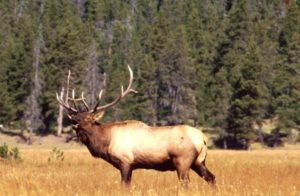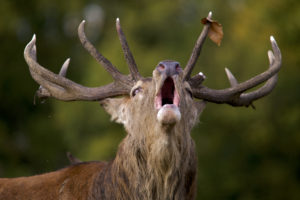
The deer family is composed of deer, caribou, elk, and moose. Con Slobodchikoff, in Chasing Doctor Doolittle, describes communication within the deer family (and many other species). He says regarding elk:
The bugling starts off as a long, eerie low-frquency screeching sound, followed by a series of three or four shorter sounds kind of like someone scratching glass on concrete. The first time one of my graduate students, newly arrived from the East Coast, heard this sound on a dark evening in the mountains he was startled and disoriented.… I told him he had heard the aggressive call of a male elk (Cervus canadensis), advertising his presence to other males and perhaps also to any females that happened to be nearby. When you hear it for the first time, it can be pretty terrifying.
Here is a male elk bugling:

Dr. Slobodchikoff goes on to discuss the call of the Red Deer stag:
Although red deer (Cervus elaphus) are similar in size and shape to elk, and in fact were thought for a long time to be the same species of animal, their calls are very different. Red deer are found in Europe, Western Asia, and Northern Africa. They have a roaring call that advertises their aggressiveness toward other males, and they make this call during the mating season when they are guarding a harem of females. Depending on the size of their opponents, the males can vary the base pitch of their roars, making the roars sound deeper when they are faced with a larger opponent. This gradation in the base pitch of the roars probably conveys information to challengers about the males’ willingness and ability to fight to defend her harem.
Source:
Con Slobodchikoff, Chasing Doctor Doolittle: Learning the Language of Animals (New York: St. Martin’s Press, 2012) 185-186.
